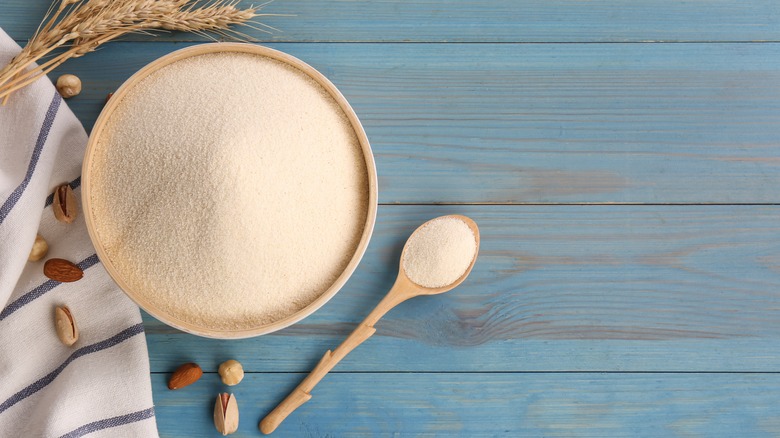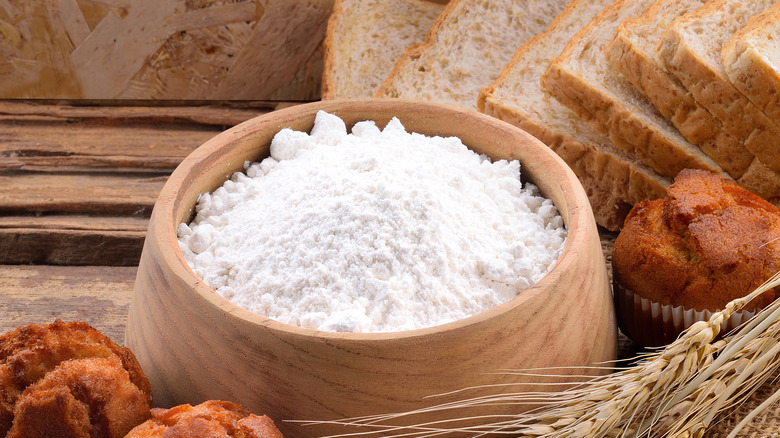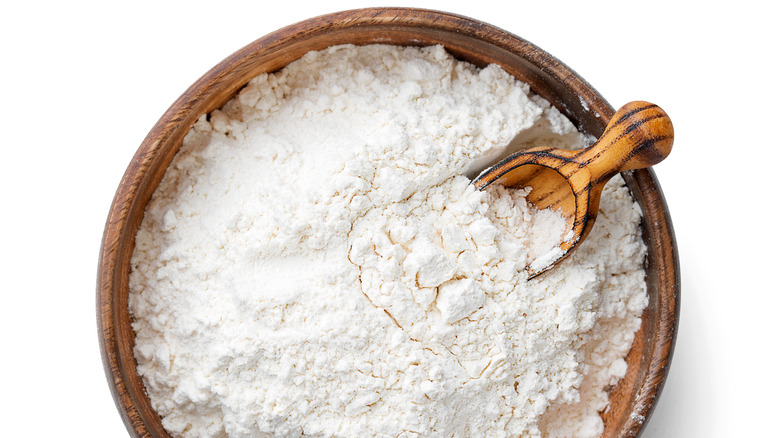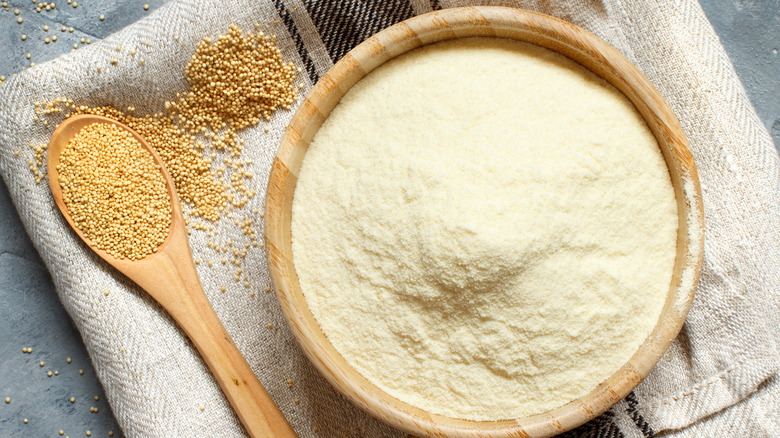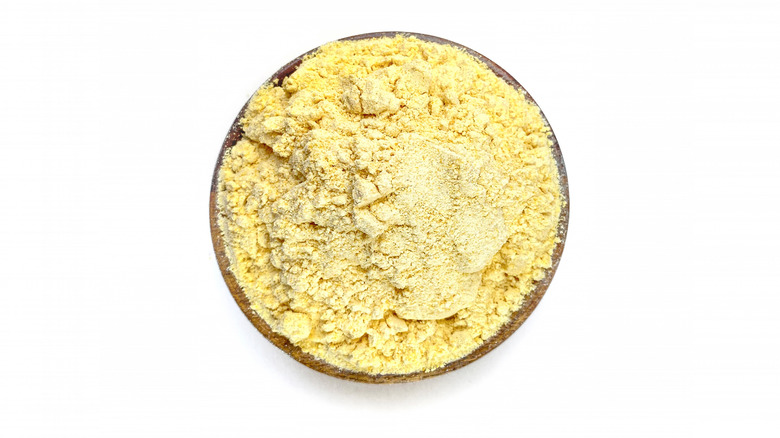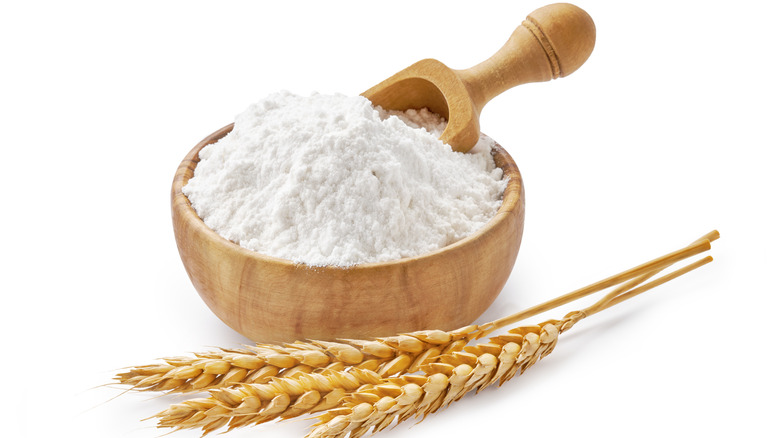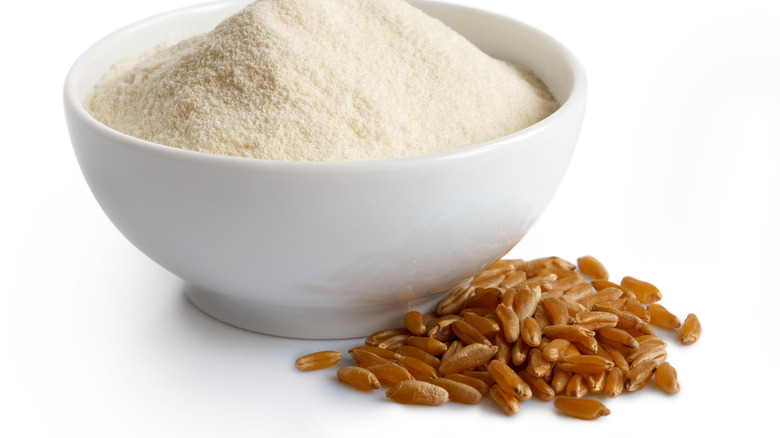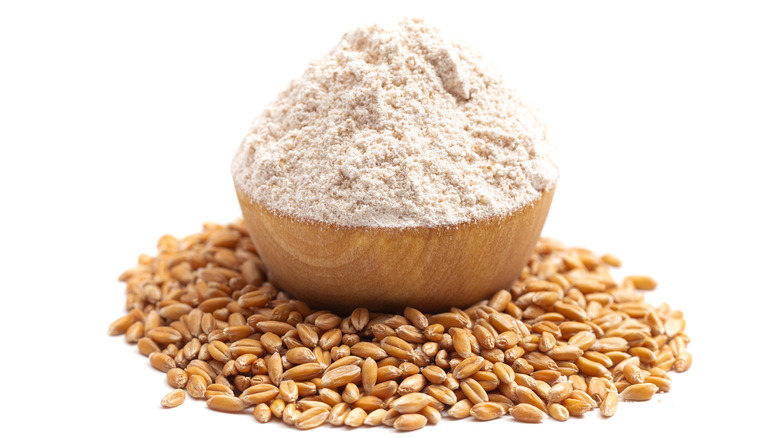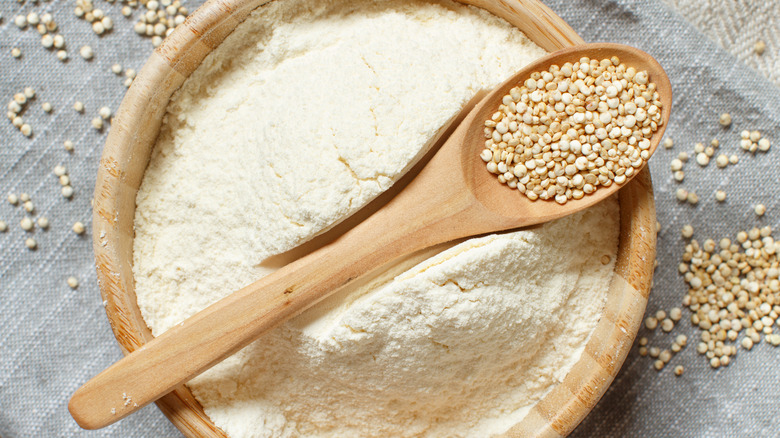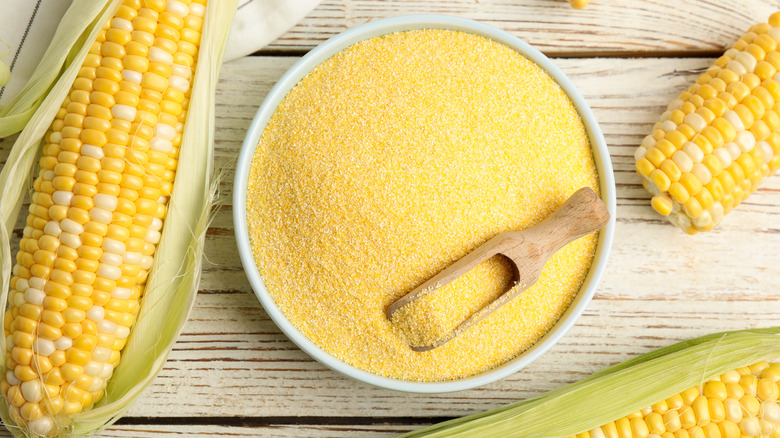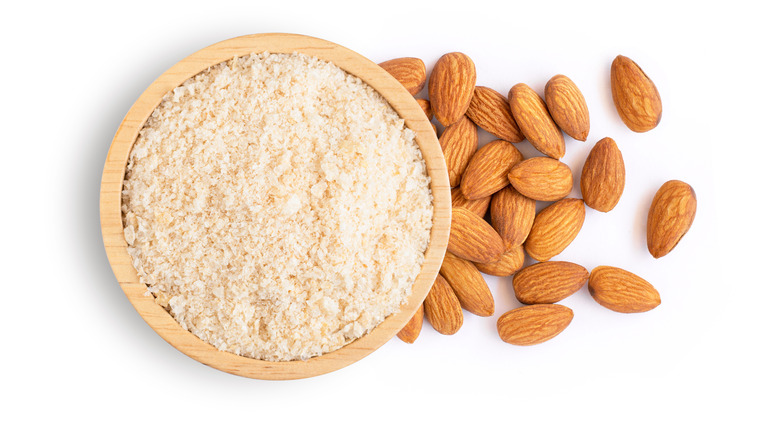10 Best Substitutes For Semolina Flour
We may receive a commission on purchases made from links.
If you've ever seen the tiny bits of golden yellow dust falling off the bottom of your slice of pizza, there's a good chance it was semolina flour. According to Cook's Illustrated, it's the ideal ingredient to coat your pizza crust with so it doesn't stick — but that's not all semolina flour does.
Semolina flour is made from hard durum wheat. It looks a lot different than your standard all-purpose flour, as it has a slightly yellow hue and typically a coarser texture, almost like cornmeal (although you can find varieties that have been ground more finely). Semolina flour is an Italian staple, preferred for pasta-making because of its high gluten content that lends elasticity to the dough. However, you can also use semolina flour for baking, to thicken soups and stews, to prevent things like pizza dough or other baked goods from sticking, to whip up a simple porridge, and much more, per Healthline.
If you happen to find yourself without the semolina flour your recipe calls for, though, don't worry — depending on what it's doing in your recipe, there are quite a few great substitutions to consider. Here are 10 of the best substitutes for semolina flour, so you've got some options based on what exactly you're whipping up and what you already have in your pantry.
1. All-Purpose Flour
One of the most accessible substitutes for semolina flour is regular all-purpose flour — it's a budget-friendly option, and it's something that just about anyone will have in their pantry. You can use either bleached or unbleached all-purpose flour, although bleached all-purpose flour has less gluten, per Delishably. Considering that all-purpose flour already has less gluten than semolina flour, for best results with this swap, unbleached is preferred. As a bonus, unbleached flour has more protein as well, according to What's Cooking America.
The one thing to be mindful of is that all-purpose flour is typically a bit softer than semolina, with a finer texture. This means that you may run the risk of your recipe getting a bit soggy or mushy if you allow it to sit and cool for too long, or the dough being a bit sticky, as Chatelaine explains. So, if you're making this swap, you'll want to ensure you get that pot of pasta or fresh-baked pizza on the table ASAP.
For best results, you can do a direct substitution, using a cup of all-purpose flour in place of a cup of semolina flour.
2. Rice Flour
If you want to swap semolina flour with something that will allow your dish to be gluten-free, rice flour can be a great option. This substitute is particularly well-suited to certain pasta dishes — many Asian noodle dishes, for example, utilize pasta crafted from rice flour. There are differences, though — rice noodles are typically a bit stickier and can be a bit gummy in some cases, as From the Larder notes, and they do tend to have a slight rice flavor.
As Leaf TV explains, rice flour also works well as a thickening agent, so you can use it in dishes like sauces, soups, stews and gravies as well. Also, the overall appearance of your dish may be different if you swap rice flour in place of semolina flour — while semolina flour has a slightly yellow hue, rice flour is typically white or sometimes brown, as per Bakerpedia.
For best results, you can do a direct substitution in this case, using a cup of rice flour in place of a cup of semolina flour.
3. Amaranth Flour
For those who may not be familiar, amaranth flour is crafted from the seeds of amaranth, a plant native to Peru, which are then ground up into a fine powder that resembles flour (via SPICEography). It makes a great substitute for semolina flour. It's also a solid pick for anyone looking to whip up a gluten-free dish, and it also packs in plenty of protein, calcium, and iron, per The Vegan Atlas.
There are just a few things to consider. First, amaranth flour can have some nutty flavor notes, per SF Gate, which you might taste in dishes that are more subtly seasoned. Additionally, it's not quite as common an ingredient as some other types of flour, which means you might not have it in your pantry or be able to find it in your local grocery store. If you do have it on hand, though, it's an easy swap!
Amaranth flour can stand in for semolina flour in a wide variety of recipes, from soups and stews to pasta. For best results, you can do a direct swap, replacing a cup of semolina flour with a cup of amaranth flour.
4. Chickpea Flour
Whether the packaging lists it as garbanzo flour or chickpea flour, this substitute created from ground chickpeas makes a great swap for semolina flour.
One benefit to using chickpea flour is that it's "naturally gluten-free," so if you're looking for a swap that can be used for Celiac diners, it's a good choice. It also has a hint of natural sweetness and nuttiness and "lends baked goods a sturdy yet tender texture," as per Epicurious, which makes it the perfect substitute to use in baking (don't worry, your baked goods won't actually end up tasting like chickpeas). Finally, like semolina, chickpea flour has a "pale yellow hue," which means your dish will end up looking roughly the same. Who knows — this swap might just be the ticket to your dream gluten-free pizza dough.
Since these two flours have quite a few things in common, they work very well as a direct swap — so, if your recipe calls for a cup of semolina flour, you'd swap in a cup of chickpea flour instead.
5. Bread Flour
If you happen to love baking your own fresh, homemade bread — or, you simply have a pantry stocked with a wide variety of flour options — you may have some bread flour on hand. It makes a good substitute for semolina flour for a few different reasons.
First of all, as Big Oven explains, one of the characteristics of semolina flour is that it makes doughs that are quite firm, even bordering on tough. Bread flour has the highest gluten and protein content of any of the normal wheat flours (i.e. all-purpose or pastry flour), as per Bon Appétit, which makes it a great swap for recipes that require semolina's structure. The one thing to be mindful of is the appearance — semolina does give dough a bit of a yellow hue, whereas bread flour is white, so your dough might be a little bit paler if you're using large amounts.
Because of the similarities between these two flours, you can do a direct swap, using a cup of bread flour in place of a cup of semolina flour in your recipe of choice.
6. Kamut Flour
If you have it on hand, you may want to consider kamut flour as a substitute for semolina flour in recipes. Sometimes called khorasan flour, kamut flour is crafted from an ancient type of wheat (via Twelve on Main). Though it's not gluten-free, it's actually a bit easier to digest than some other types of wheat flour, according to Foods Guy, which makes it a perfect option for those who may not be Celiac, but still have some sensitivities to gluten.
Kamut flour packs in more nutrition than regular wheat flour, with plenty of manganese, selenium, zinc, iron, and B vitamins, as well as a high protein content. Additionally, while the overall flavor profile is quite neutral, it does have a hint of nuttiness that mimics semolina's flavor very well, as per Foods Guy. The one downside to this substitution is that it's not quite as widely available as some of the other options, so if you have a smaller grocery store with just the basics, you may have trouble finding it.
For best results, you can do a direct swap, using a cup of kamut flour in place of a cup of semolina flour in your dish.
7. Spelt Flour
Spelt flour is another great substitute for semolina flour, and is packed with all kinds of nutrients such as calcium, magnesium, fiber, and iron (via Verywell Fit). Like semolina flour, it also has a relatively high protein content, which also packs in additional nutrition.
Spelt flour works for a wide variety of dishes, as it's a relatively neutral-tasting with just a hint of nuttiness, per Masterclass. Its flavor profile is actually quite similar to semolina, making it a relatively seamless swap. If used for baking, spelt's high protein content makes it particularly well-suited to yeast-leavened goods such as breads or buns (via Bakerpedia).
Like other flours in the wheat family that are quite different from all-purpose flour, spelt is a little bit easier to digest than regular all-purpose flour, according to One Green Planet, which makes it a great pick for those sensitive to gluten (although it does still contain it, so Celiacs beware).
You'll want to be a bit heavy handed — Food Gal suggests using about 1.5 cups of spelt flour in place of 1 cup of semolina flour in your recipe.
8. Quinoa Flour
If you love to try different grains, there's a good chance you have a bag of quinoa somewhere in your pantry. Whether you decide to make your own quinoa flour — which can easily be done by just blitzing quinoa in a food processor until it's a fine powder, per Super Healthy Kids — or whether you have a bag of quinoa flour on hand, it makes a great substitute for semolina flour.
As you may guess based on the way quinoa delivers a punch of plant-based protein to recipes, the flour itself is likewise fairly high in protein, per Simply Quinoa. This means it behaves similarly to semolina — that protein helps give whatever you're making a bit of structure, which makes it a great pick for baking. Additionally, since quinoa is gluten-free, this swap can help transform your dish into something safe for those with Celiac disease to consume. The one thing to note is that some people can find quinoa a tad bitter — if you're in that camp, you can address that by lightly toasting the flour before incorporating it.
For best results, you can do a direct swap in your recipe, replacing a cup of semolina flour with a cup of quinoa flour.
9. Cornmeal
All the home cooks who love to whip up Southern fare like cornbread, take note — cornmeal is actually a very good substitute for semolina flour, according to Bob's Red Mill, so that pantry staple will come in handy more than you thought it would.
Semolina flour and cornmeal may actually be hard to distinguish when take out of their packages and placed side-by-side, as they both have a similar yellow hue and slightly coarse consistency (via Real Simple). This means that this swap can be great for recipes where you really want that visual similarity — for example, sprinkling some on your pizza pan, as Sally's Baking Addiction advises, adds a bit of crunch and prevents dough from sticking. While semolina flour has a slight nutty flavor, cornmeal has a bit of sweetness, per Fiesta Farms, but it works very well in a wide variety of recipes. Cornmeal also works very well to thicken dishes, so this can be a great substitute if you're looking to achieve a thicker consistency in whatever you're making (via The Kitchn).
For best results, you want to use a bit less cornmeal than semolina to get the same result — so, if your recipe calls for 1 cup of semolina flour, for example, you'd swap in about ¾ cup of cornmeal.
10. Almond flour
Anyone who experiments with gluten-free baking — or has tried to perfect the finicky French macaron — likely has a bag of almond flour in their pantry. Fortunately, this naturally gluten-free option makes a fantastic substitution for semolina flour.
Almond flour is obviously a great swap for anyone with gluten sensitivities. It also features a hint of nutty sweetness, which makes it very well suited to sweet dishes, and it's a solid pick for cookies, muffins, and pancakes. Health-conscious cooks will be thrilled to know it also packs a nutritional punch, containing manganese, Vitamin E, magnesium and more (via Healthline).
Though the color is a little different from semolina flour, you'll get a somewhat similar texture if you go for almond flour and not almond meal — while almond meal is silky smooth, almond flour has a bit more grit, thanks to the inclusion of the nut skins, per Minimalist Baker. Another plus is that, while almond flour can definitely be pricey in comparison to all-purpose flour and other commonly found flours, the increase in gluten-free options means it is available in a wider range of grocery stores than it once was.
For best results, you can do a direct swap with this particular substitution, meaning that if your recipe requires 1 cup of semolina flour, you could add in 1 cup of almond flour instead.
